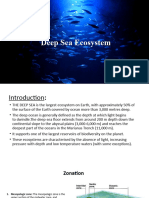Exploring the Deep Sea: A Study Guide
Quiz
Describe the photic zone and its significance for the ocean ecosystem.
What is the continental slope and how does the environment change as one descends it?
Explain the concept of bioluminescence and provide two potential functions it serves for deep-
sea organisms.
What is marine snow and why is it a crucial resource for life in the deep sea?
Describe two adaptations that deep-sea predators have developed to successfully hunt in the
darkness.
What are the key characteristics of the abyssal zone and how do animals living there conserve
energy?
Explain the unique ecosystems found at hydrothermal vents and the organisms that form their
base.
What defines the hadal zone and what types of organisms are typically found in these
environments?
Describe the conditions at the Challenger Deep and give an example of a creature that has
adapted to survive there.
How has human influence reached even the deepest parts of the ocean, as mentioned in the
source?
Quiz Answer Key
The photic zone is the uppermost 200 meters of the ocean where sunlight can still penetrate,
allowing phytoplankton to photosynthesize. This zone is the foundation of the ocean's
ecosystem because phytoplankton are the primary producers, forming the base of the food web.
The continental slope is the steep descent from the edge of the continental shelf down to the
deep sea. As one descends, light fades drastically, plant life disappears, and the environment
becomes increasingly dark and pressured, resembling a barren landscape.
Bioluminescence is the production of light by living organisms through chemical reactions. In the
deep sea, it can be used as camouflage against faint sunlight, to attract mates or prey through
signaling, or to confuse and scare away predators.
Marine snow is a continuous shower of organic detritus falling from the upper layers of the
ocean, consisting of dead plant and animal parts, fecal matter, shells, sand, and dust. It is a
crucial resource for deep-sea life as it provides the primary source of nutrients in the absence of
sunlight for photosynthesis.
One adaptation of deep-sea predators is having multiple sets of long, sharp teeth designed to
ensure a secure grip on prey in the darkness, preventing escape. Another is energy-efficient
hunting strategies, such as the vampire squid's motionless drifting with extended catching arms,
to conserve energy in a food-scarce environment.
The abyssal zone is characterized by utter darkness, extreme pressure, and very low
temperatures. Animals living here conserve energy by moving slowly and deliberately, often
hovering motionlessly, and only expending energy for essential activities like escaping danger.
Hydrothermal vents are found in rift valleys where tectonic plates diverge, releasing heated
seawater and minerals. Extremophile bacteria at these vents utilize chemosynthesis to convert
minerals into organic matter, forming the base of unique ecosystems that support specialized
organisms like tube worms and certain crustaceans.
�The hadal zone consists of the deepest parts of the ocean, found in long, narrow trenches, and
represents the most extreme marine environments with immense pressure. Only extremophiles,
organisms adapted to these harsh conditions like the ethereal snailfish and specialized
amphipods, can survive there.
The Challenger Deep, located in the Mariana Trench, is the deepest point in the ocean with
incredibly high water pressure (1,086 bar, equivalent to 1,800 elephants on top of you). Despite
these extreme conditions, life exists here, including sea cucumbers and surprisingly large
amphipods.
Human influence has reached even the Challenger Deep, as evidenced by the discovery of
plastic bags by scientists in 2018, highlighting the pervasive impact of pollution on even the
most remote environments on Earth.
Essay Format Questions
Discuss the challenges and adaptations of life in the deep sea, focusing on the decreasing
availability of light and increasing pressure as depth increases.
Analyze the role of marine snow and hydrothermal vents as primary sources of energy and
nutrients for deep-sea ecosystems. Compare and contrast the communities that thrive in these
two distinct environments.
Explore the various functions of bioluminescence in the twilight and midnight zones of the deep
sea, providing specific examples of how different organisms utilize this phenomenon for survival
and reproduction.
Consider the importance of the deep sea in the overall global ecosystem, despite its relatively
small proportion of Earth's biomass. Discuss the potential consequences of human activities,
such as pollution and resource extraction, on this fragile environment.
Based on the information provided, what are some of the major unanswered questions and
future directions for research in the exploration of the deep sea?
Glossary of Key Terms
Biomass: The total mass of living organisms in a given area or volume.
Photic Zone: The uppermost layer of a body of water that receives sunlight, allowing
photosynthesis to occur (typically the top 200 meters of the ocean).
Phytoplankton: Microscopic marine algae and bacteria that perform photosynthesis; they form
the base of many aquatic food webs.
Continental Shelf: A gently sloping, submerged extension of a continent that extends from the
shoreline to the continental slope.
Continental Slope: The steeper incline extending from the edge of the continental shelf down to
the deep ocean floor.
Twilight Zone (Disphotic Zone): The dimly lit zone of the ocean below the photic zone, where
some light penetrates but not enough for photosynthesis to occur significantly (roughly 200 to
1,000 meters).
Bioluminescence: The production and emission of light by a living organism.
Marine Snow: Organic detritus that falls from the upper layers of the ocean to the deep sea,
consisting of dead organisms, fecal matter, and other particles.
Midnight Zone (Aphotic Zone): The deepest layer of the ocean where no sunlight penetrates
(below approximately 1,000 meters).
Abyssal Zone: The part of the deep ocean floor at depths of 4,000 to 6,000 meters.
�Abyssal Plain: A flat or gently sloping area of the deep ocean floor, typically covered in fine
sediment.
Manganese Nodules: Rounded masses of minerals (primarily manganese and iron) found on
the deep ocean floor.
Hydrothermal Vents: Openings in the seafloor that release geothermally heated water and
dissolved minerals.
Extremophile: An organism that thrives in extreme environments, such as high or low
temperatures, extreme pressure, or high salinity.
Chemosynthesis: The synthesis of organic compounds by bacteria or other living organisms
using energy derived from reactions involving inorganic chemicals, typically in the absence of
sunlight.
Hadal Zone: The deepest parts of the ocean, found in deep-sea trenches below 6,000 meters.
Challenger Deep: The deepest known point in the Earth's oceans, located in the Mariana
Trench.
Amphipod: A type of small crustacean with a laterally compressed body.
























































































